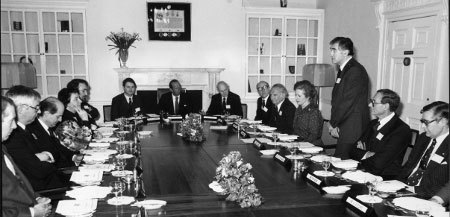
The photograph shows the president, Frank Hooper, next to Mrs Thatcher. On her right is Peter Hall, his predecessor. At the head of the table is the Duke of Kent and I am on his right. The only other woman in the room is Steve Shirley, later our president, and on her right is Alex d'Agapeyeff.
Prior to the 1979 election, a small Tory party working group was addressing the IT policy document for the 1979 election when Jim Callaghan called it rather suddenly. My working draft-for-discussion of a possible strategy document was rapidly promoted to a manifesto. After the election, I was drafted into the Central Policy Review Staff (the Think Tank) and spent the first year mainly thinking about IT policy and strategy. After a lot of consultation within Whitehall, with the IT industry and with the profession, particularly other members of BCS, the necessary changes in the machinery of government where agreed: a Minister for IT, an all-party Parliamentary Information Technology Committee, an inter-departmental committee of senior officials chaired by the Department of Industry and a small four-man IT Unit in the Cabinet Office.
When at the end of its life, the IT unit closed following the 1983 election, 186 policy issue files were archived, covering such issues as: the privatisation and liberalisation of telecommunications, the future of computer manufacturing, the support of the software industry, the international implications of trans-border data flows, the IT procurement strategy for the government, and the achievements of IT 82, the IT year. The policy for broadcasting by satellite, the implications of the internet, privacy and data protection, international standards, procurement of IT, education about and through IT at school and university level, research in computer sciences and international collaboration on IT issues at EU and in UN agencies. We foresaw the convergence of the information and communications technologies but the respective industries and professions had not yet come together.
As an active member of BCS, I could draw on and channel the pertinent knowledge and experience of the society. Work was going on in working parties, specialist groups and out-reach networks of hundreds of members, so the IT Unit was not short of professional advice. The society also played a major role in promoting IT to a wider public, particularly in IT year 82 and World Telecommunications Year 83. My three colleagues in the IT Unit had similar networks in the civil service, government sponsored research, industry and, through the Minister for IT, Kenneth Baker, and PITCOM, the political issues.
The Prime Minister's interest was critical. Her visit to the BCS was both symbolic and purposeful: to hear the views of the professionals and to enlist their support.
Adrian R D Norman FBCS












